Sunpatiens is the answer to all who love Impatiens and wish to see them bloom in full sun!
Key Sunpatiens facts
Name – Sunpatiens ®
Scientific name – Impatiens hawkeri hybrid
Family – Balsaminaceae
Type – perennial indoors, annual outdoors
Exposure – sun and part sun
Soil – ordinary but not soggy
Height – about 16 inches (40 cm)
Flowering – May to September-October.
You’ll be able to decorate your beds, garden boxes and pots in the sun with this touch-me-not for many long months.
Planting Sunpatiens
How to plant Sunpatiens to the ground or to a pot
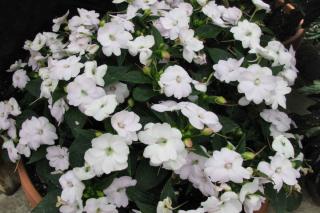
- Favor sun or part sun.
- The ground or pot must drain well and have a lot of humus.
- Plant mulch will retain water and slowly convert to humus over the season.
- Plant many together, spaced about 16 inches (40 cm) from the next to create a nice cover.
- Note: setting up drip irrigation helps in hot, dry places. Set a timer, because continuous water would rot your sunpatiens.
Space the plants according to what fits your landscaping best:
- tighter clusters (about 1 foot or 30 cm apart) will lead them to grow taller and will form a uniform cover.
- loose clusters (about 2 feet or 60 cm) will let plants spread into a nice, round mounds that are a bit shorter overall.
Then, mix your earth with flower plant soil mix and water often in summer for abundant flower-bearing.
Propagating Sunpatiens
From a biological point of view, it’s possible to propagate Sunpatiens from seeds and cuttings. However, restrictions apply because it’s patented, and you’re not allowed to.
Caring for and pruning sunpatiens ®
Care for sunpatiens is child’s play and no pruning nor pinching is required. It naturally branches out.
- Water regularly in case of heat waves.
- Add flower plant fertilizer to enhance blooming, but you’ll still have many flowers if you don’t.
In pots or garden boxes, amplify the appeal and stimulate budding of new flowers by removing wilted flowers regularly (deadheading).
Temperature range for Sunpatiens
- Possible growing within the 32°F – 117°F (0°C to 47°C) range.
- Thriving only within the 40°F – 95°F range, (5°C to 35°C), its comfort range.
Diseases and enemies of sunpatiens
This flower is more resistant than most impatiens, but it still occasionally does get sick. Find more details on sunpatiens pests and diseases here.
Sunpatiens winter care
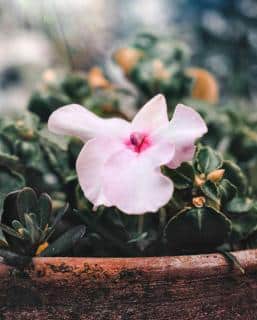
- But you can try growing sunpatiens in pots to bring inside your home during colder months.
- If the lowest temperatures in your area are around freezing, winterize your sunpatiens to avoid problems.
Uprooting your sunpatiens ® from the growing bed into containers is also possible.
- Dig the plant out carefully with as many roots as you can.
- Transfer to a pot with conventional soil mix.
- Trim stems back by about one third (leaving two-thirds on the plant).
- Set the sunpatiens ® indoors near a window that provides a lot of sun.
When growing the plants in pots, reduce watering to only once a fortnight or once a month during the winter, as you would most house plants. Don’t add any fertilizer during winter.
Learn more about sunpatiens ®
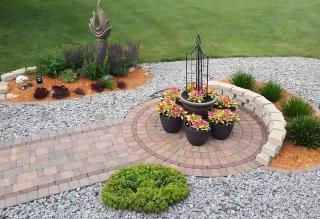
- Care is simple and growth is quick.
- Resistance to full sun and warm weather is what makes this Impatiens stand out.
There are three major types of sun impatiens
- Sunpatiens ‘Compact‘ – grows up to 2½ feet (75 cm) tall
- Sunpatiens ‘Spreading‘ – reaches heights of up to 3 feet (90 cm)
- Sunpatiens ‘Vigorous‘ – makes it over 3½ feet (105 cm) high
Where does Sunpatiens come from?
This Impatiens hybrid was bred from ‘New Guinea’ Impatiens, which itself was already an improvement over common Impatiens as regards heat resistance.
Indeed, traditional Impatiens varieties would only thrive in the shade but wither away when temperatures increased. Thanks to a dense, fast-growing root system, Sunpatiens ® is able to resist high temperatures.
- However, it isn’t drought-resistant so regular watering is important.
Why the “®”? Sunpatiens ® is a development of the Sakata Seed Corporation, which set the trademark name specifically for merchandising. This is the name most horticulture stores will sell the plant under, but the scientific name is Impatiens hawkeri hybrid.
This Japan-based company worked with local growers and the Indonesian Department of Agriculture to breed the plant. They’re constantly adding new colors such as fire red, tropical rose, neon pink, magenta and more colors from the orange to purple range.
- Unlike other cases of “pillaging”, Sakata Seed Corporation has agreed to share some of its royalties with the Indonesian government for the continued use of those native Indonesian plants.
- In exchange, Sakata Seed corporation is entitled to preferential treatment regarding the exploitation of new strains to develop new plants.
Smart tip about Sunpatiens ®
During the blooming, feel free to water your sunpatiens ® regularly but not too much to keep just the right moisture level.
CC BY 2.0: Serres Fortier
CC BY-SA 2.0: F. D. Richards

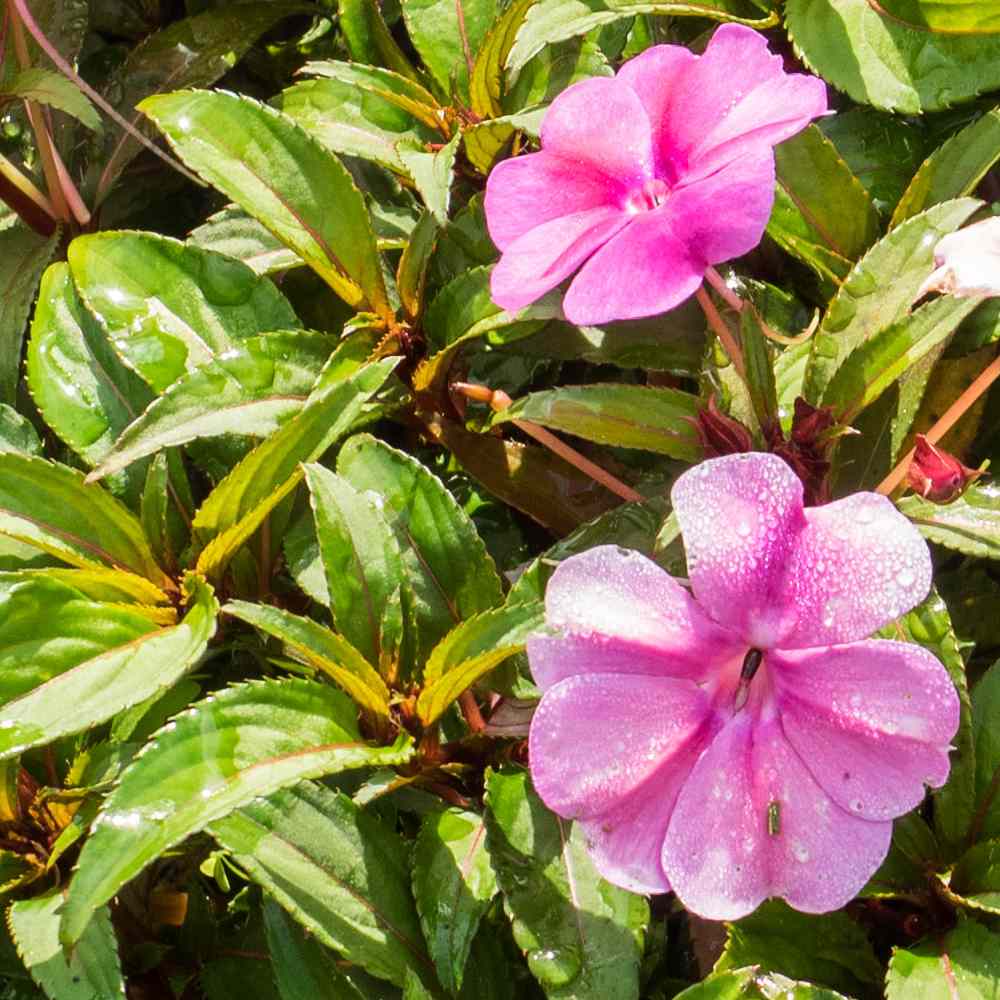
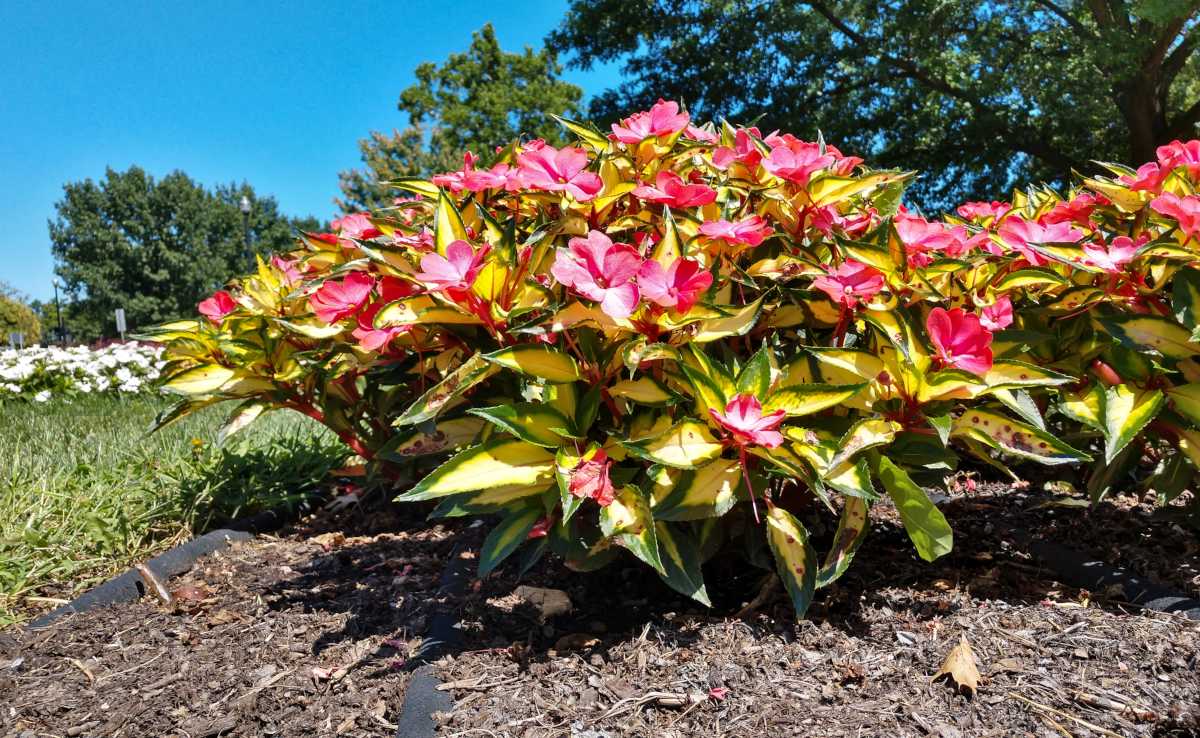

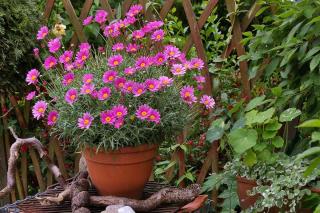

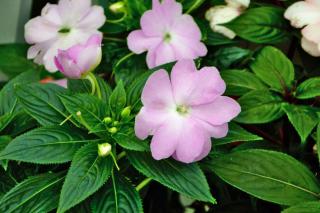
We went shopping to pick up some plants to get into the ground before winter hits us in northwest Montana. I saw these plants, not knowing what they are until now. Problem is, I got all of them planted yesterday, 12 total, and put some compost around them. They were terribly root bound. Question is, will they last through the winter if I cover them in straw or should I transplant them? I think I know the answer, but I didn’t see any questions from anybody who lives in a harsh winter area. Any further care suggestions for winter care would be appreciated.
Hello Karen, I got carried away with other things and your comment got buried under mulch… Well, as you’ve probably guessed, any temperature that’s at or below freezing is fatal to Sunpatiens. They’re the kind of annual that has really zero chance of surviving even frost. Covering with straw would work if it only got to 32°F (0°F) but no lower, and then only for a short while. Montana gets much colder than that.
You can definitely pull them out and pot them up to keep them alive indoors. A cool spot with light and minimal watering would do the trick. However, they tend to grow scraggly during the time indoors. Sakata Seed Corp, the company that breeds it, simply recommends buying new ones started from cuttings when spring comes back.
I bought two beautiful sunpatiens and planted them in pots, watered and placed in full sun. They have since started dropping blooms and leaves (within 3 days). I continue to water but it does not look like they will survive. HELP
Hi Cody, within so short a time span, it’s almost certainly transplant shock. Sunpatiens is a heat-resistant plant, but not drought-resistant, so it still needs lots of water, especially in full sun, and even more so in pots since pots tend to dry out faster. If they’re terra cotta pots, try wrapping the pots with plastic wrap to reduce evaporation for a while (leave the hole open underneath for drainage). Or, find a nice “pot holder” that can keep the wind from drying the pot material out. Secondly, try to water morning and evening. You can’t set a drip irrigation up in pots, unless you start looking for those upside-down bottle dispenser systems, they work well enough.
I suspect they had lots of water in the nursery, and less so at your house (which is normal), so the goal is to slowly get them to readapt their growing and blooming to the “new normal”. Don’t worry – if you get them more water, they’ll bounce back.
Last of all, a slight suspicion: please check that it drains well. If the plants wallow in water, they’ll quickly die of rot as shown in this article.
Thank you for all this great info! I’ve found it hard to find much about Sunpatiens. Do you know if they are prone to being eaten by deer or groundhogs? I know when an animal is hungry it won’t be too picky but curious if this plant is one that naturally tempts them.
Thank you for all the information. I only had one plant in a pot last summer and it was so beautiful. So now I have purchased 12 plants to put out front of our boxwood hedges. I cannot wait to see how they will do.
Wow, Carolyn, that will definitely be a stunning front! Can’t wait to see pictures!
I am so interested in planting Sunpatiens from seeds but I can’t find anything on the web selling just the seeds. Any suggestions on where to purchase seeds?
Hello Russ, it’s true that it’s almost impossible to find seeds. That’s because the plant is only sold as propagated clones – it’s the only way to really ensure all the advantages of the Sunpatiens plant (heat resistance, colors, etc). Indeed, due to cross-pollination, any seeds that appear wouldn’t be identical to the parent. Some features might change. This is because the species hasn’t been bred and selected over generations. It’s simply a first-generation hybrid, and traits of such hybrids tend to revert to less desirable but more natural features. So nobody can confidently market seeds as Sunpatiens because it won’t have the same properties as the parent.
However, the plant does sometimes go to seed. These can be harvested and then planted. To get your hands on some, you’d have to get in touch with someone who has already planted them and been able to collect a few seeds. It’s not too difficult, since the plant has now been planted for several years already.
I am propagating Sunpatiens from cuttings taken through the summer months. One thing I am never certain about is how much water the cuttings need. Too much water or too little water can give problems later on, like late blooming etc. I have recently purchased a water meter which shows you how wet, moist or dry the soil is, would I be correct in saying that it is best to keep the meter reading on moist to dry as the best option?
Hello again Richard! Yes, that would be exactly the right setting. To help keep moisture constant, you can do the following. Try only one or combine the techniques if you wish to experiment.
– avoid direct sunlight on your cuttings. This dries the soil out very fast, especially if set behind a window (a small greenhouse effect speeds the drying up there).
– try “bagging” your cuttings. This means taking your seedlings and putting them in large sealable freezing bags (Ziploc-like). Place your water meter in one bag to check if it isn’t too moist. If too wet, then open the bags up for a couple hours. Moisture will evaporate and you can seal and measure again. With this technique it’s very important to avoid direct sun, as the bags would quickly heat up like a greenhouse.
– if not bagging, compensate drying by resting your cuttings on a tray covered in clay pebbles. Keep them constantly wet. This won’t interfere with the rooting since the soil doesn’t touch it, but it will provide moisture all around the area which is perfect.
Hope this helps, Richard!
Hi Gaspard thanks for your reply.
All of my cuttings are in 3″and 5″ pots and put into trays with a gravel bedding. I am growing my cuttings in a summerhouse which has windows but possibly light may be an issue and is lightly heated to a temperature of around 50-60F. I Have lost some cuttings where the leaves drop off the main stem of the plant. Strangely nearly all the cuttings I have lost are white, I have a lot of lilac and orange cuttings grown under the same conditions which are ok. I will try and send some pictures if I can get my head around the i-phone technology.
Many thanks for your assistance.
It seems to me your setup is nearly perfect. You’ve now got everything covered: temperature, moisture, exposure… If you fear there’s too much sun, simply stretch a thin veil above the cuttings, but this isn’t so important now that moisture is controlled. It must be fun to see those cuttings thrive!
My sunpatients have grown and constantly flower but flowers wilt in the hot sun. I thought that these plants tolerate sun. I have kept them moist and well drained but not soggy. Can you tell me why the flowers on these plants wilt dramatically in the sun?
Hi Denise, it depends on how hot it gets. Regular impatiens tend to stop blooming entirely as soon as temperatures hit 80°F (26°C). Sunpatiens were bred from stock that can take more heat, but they also tend to bloom less and less as average daily temperatures keep rising. A “hot day” for sunpatiens starts from 95°F (35°C) and up.
If heat hits unexpectedly, the plant doesn’t yet have a strong enough root system to cope. It wilts in order to conserve water. If hot days keep on coming, the root system will develop and the plant should cope better and better. Best is to lather a layer of mulch to keep water in. Watering in the morning will also help. Direct water to the roots/ground instead of getting the leaves wet to avoid spots on leaves.
If you expect it to get even hotter this season, you might need to transplant your sunpatiens to a new, cooler location.
I have about 60 sunpatience. They are the variegated leaves, which is different they what I planted last year. They are growing and blooming but not as good as they should. I’m having the leaves get brown spots. I don’t notice any aphids. We have had a lot of rain, would they get this way if they are too wet?
Hello Joyce! It’s rather surprising for your sunpatiens to get variegated leaves. You’re correct in thinking this isn’t normal, but that might be a good surprise since many people find variegated leaves very beautiful.
However, it may be that it isn’t variegation but some type of disease. Did you check for sunpatiens root rot? This isn’t normally connected to brown spots but excessive water drowning out the roots would weaken the plant and make it more vulnerable to diseases. Although you can’t do much about excessive rain, you can increase soil drainage by bringing on more animal life in your soil, with mulch. Good plant mulch attracts worms which dig galleries that drain excess water away.
Usually spots on leaves are either the sign of a kind of gall growing on the underside of the leaf or, more commonly, a fungal disease. Sometimes, if only a few plants are infected, it’s best to remove them to avoid the disease spreading to neighbors. Treat fungal disease with a natural fertilizer such as fermented tea (horsetail works great).
Can sunpatiens get too much sun? Mine are in sun from sun up til sun down is that too much sun?
Hi Lori! No, it’s almost impossible for sunpatiens to have too much sun. The only thing is that they need quite a lot of water.
A great solution is to add plant mulch, this will help control water evaporation.
My sunpatiens are rotting at the top! What is this and what should I do? Thx!!!
Dear Beresa, it seems your sunpatiens is under attack by some type of fungus. Two strands are most known to infect the plant, Pythium and Rhizoctonia. Since you mentioned the rotting is starting at the crown or top of the plant, I’m inclined to think it’s the latter. To fend off Rhizoctonia, you should:
Hope this helps!
Hi Gaspard.
Thanks for your comments and helpful advice regarding my Sunpatiens. At last I now have a fantastic flush of orange, lilac and white from my plants even if it is now mid July here. We are experiencing one of the hottest summers in England for many years, maybe that may have something to do with the late blooming?
Hi Richard, thanks for your feed-back! Yes, this heat wave is triggering coping mechanisms in many plants, delaying blooming is a favorite. Just keep them well-watered, because they’re heat-resistant, not drought resistant! Glad to have been of service!
I have overwintered my sunpatiens cuttings and have lots of plants but not many of them have come to bloom yet (early july?), there are plenty of buds on the plants and some are just beginning to bloom now, is it something I have done during the propagation period?
Have grown in 3″ pots and in lightly heated propagators.
Hello Richard! Congratulations for all your cuttings! Roots start developing within about three weeks when cuttings are started. It may be that during this period, the soil mix dried off a bit too much at a time: water stress during rooting has been shown to delay blooming for sunpatiens. You can also try pinching buds on a few plants, this might jolt them into producing new flower-bearing stems. And definitely mark off plants that did bloom faster with a ribbon: they’ve proven to be more adapted to your way of working and should do even better in the next round of cuttings!